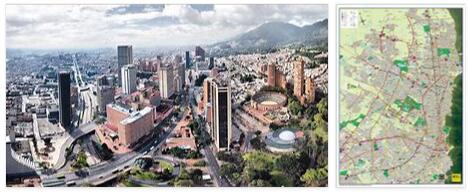Bogota is the capital of the Republic of Colombia, the capital of the Cundinamarca department and the largest city in the country.
Bogota was founded by Spanish colonizers in 1538 in an area that was the center of the ancient civilization of the Chibcha Indians. The city got its name after the most powerful ruler of the Indians in the area, who bore just such a name – Bogotá. The city is located on the site of the Indian fortress Bakata. From 1598, Bogota was the capital of the Spanish captaincy general, and from 1739, the capital of the viceroyalty of New Granada. In 1573, the Archbishop of Bogota, Luis Zapata de Cardenas, declared Saint Isabella the protector of the city.
The capital of the Federative Republic of Colombia, Bogota became in 1819, after it was liberated from the Spaniards by the army of Simon Bolivar, and since 1886 – Colombia.
Bogota is located in a basin on the western slope of the Eastern Cordillera, at an altitude of 2610 m above sea level. The city was built on the banks of the small river Rio San Francisco, today the river has gone underground and flows through pipes under the city. Although the capital of Colombia is located almost on the equator, it is not hot there due to its high altitude. The average temperature of the warmest month is +15 degrees, and the coldest is about +14 degrees, that is, all months are almost the same. This roughly corresponds to the second half of May in Moscow. During the daytime, the air temperature is 19-22°C, at night 7-11°C. Sometimes frosts are possible in Bogota, and less often snowfalls.
Bogotá, the largest city in the country, combines modern architecture, colonial churches and mansions, various museums – and at the same time it is a city of slums and eternal traffic jams, with all this, the city is also the cultural center of the country.
The main square of the city is Plaza Bolivar. On this square there is a monument to Simon Bolivar, also on the square there is a cathedral, founded in 1572. But its construction was completed only by 1610. Moreover, already at the beginning of the nineteenth century, this cathedral was rebuilt in the style of classicism. Not far from it is the Presidential Palace, where the ceremony of changing the guard of honor takes place every day at exactly 17:00. The old center of Bogotá consists of small streets. There are many different architectural monuments that have been preserved since the seventeenth century.
In addition, the buildings of the National Capitol, the National Conservatory and the National Symphony Orchestra, the Columbian Academy, the National University of Columbia opened in 1867, as well as numerous museums of the city deserve attention in the capital: the Museum of Gold, which contains works of art made by Indians in the pre-Columbian period; National Archaeological Museum; Museum of Arts and Folk Traditions; Museum of Traditional Art; Museum of Urban Development; Museum of Colonial Art; Museum of Anthropology; Museum of Science and Technology; Maritime Museum; Museum of Religious Art; Museum of Numismatics and House Museum of Simon Bolivar.
At the top of the “hill of wonders” Cerro de Montserrat is the monastery of San Vincente (XVII century), which leads to serpentine stairs and a cable car, from here you can enjoy a magnificent view of the capital of Colombia.
It is worth visiting such areas of the city as: La Candelaria with colonial buildings, churches and picturesque streets, whose Palacio de San Francisco and the churches of La Tercera, La Veracruz and San Francisco, Plaza de Santander and the University of Rosario on the square of the same name, are also among the best historical monuments of the capital; El Salitre, with its many parks and open green areas, is the best place for sports and a relaxing holiday in the capital. The most cozy corners of the area are the Unidad Deportiva el Salitre park, the Jardin Botanico botanical gardens, the water park, the Palacio de Los Deportes, the Los Niños “children’s museum” and the Simon Bolivar Central Park (1966) – the largest city park complex. There are several artificial lakes, cycling and walking paths, an extensive green area and a kind of green theater; La Macarena – the bohemian district of the city with its art galleries and the best restaurants in the capital; the district of Usaken, which is a tiny village with cobblestone pavements, miraculously survived among city blocks; in the El Campin area is the largest stadium in the capital and an extensive sports and entertainment area; La Zona Rosa is widely known for its discos and restaurants.
49 km from Bogota, near the town of Zipaquira, there is the famous salt cathedral, entirely carved into the salt rock. With a vault height of 23 m, the cathedral can simultaneously accommodate over 10 thousand people, and the vaults and walls covered with myriads of salt crystals create an indescribable play of light here.
50 km northeast of Bogota is the colorful colonial city of Guatavita and Laguna de Guatavita, widely known as the ancient ritual center and the sacred lake of the Muisca Indians, the cradle of the myth of Eldorado.
